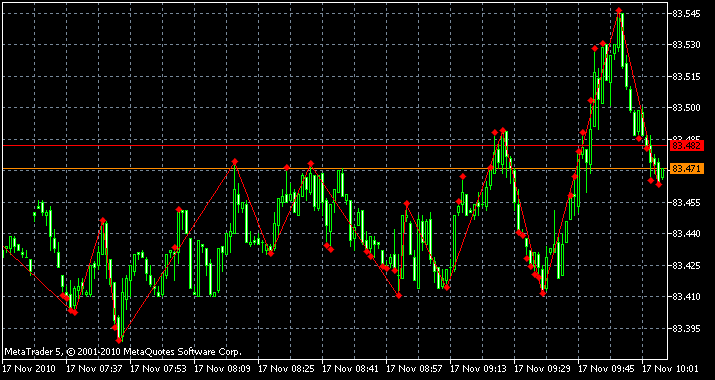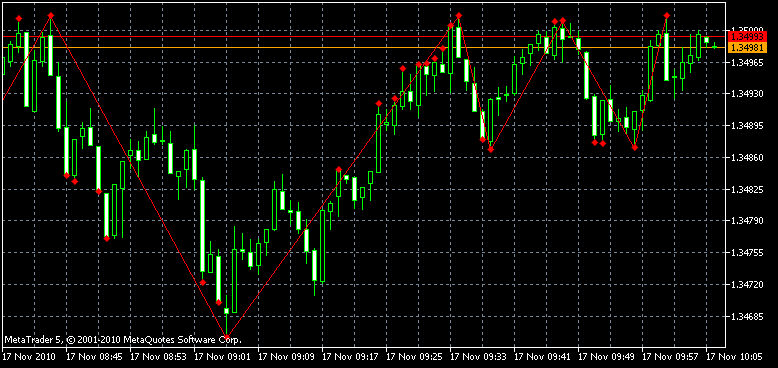【解説】【MQL5 community】 ZigZagNN : ZigZag, Zigzag Color の最大値, 最小値を再度計算し直し, その点に赤い印を付与するというもの。
ある期間のトップとボトムをつなぐ線。エリオット波動理論のジグザグのラインでもある。直近高値から5%(デフォルト)以上の反落があった場合、ここでジグザグの向きが反転する。この反転をもって「買い・売り」シグナルとします。
一見すると、ジグザグ線を移動平均のようにして使えそうです。しかし線が確定するまで時間がかかるので、この意味では使えない。だたトレンドを把握するのには使える。
//+------------------------------------------------------------------+
//| ZigZagNN.mq5 |
//| yu-sha@ukr.net |
//| http://www.mql5.com |
//+------------------------------------------------------------------+
#property indicator_chart_window
#property indicator_buffers 4
#property indicator_plots 2
//---- plot Zigzag
#property indicator_label1 "Extremums"
#property indicator_type1 DRAW_ARROW
#property indicator_color1 Red
#property indicator_label2 "Zigzag"
#property indicator_type2 DRAW_SECTION
#property indicator_color2 Red
#property indicator_style2 STYLE_SOLID
#property indicator_width2 1
//--- input parameters
input int ExtDepth=12;
input int ExtDeviation=5;
input int ExtBackstep=3;
//--- indicator buffers
double Extremums[]; // extremum buffer
double ZigzagBuffer[]; // main buffer
double HighMapBuffer[]; // highs
double LowMapBuffer[]; // lows
int level=3; // recounting depth
double deviation; // deviation in points
//+------------------------------------------------------------------+
//| Custom indicator initialization function |
//+------------------------------------------------------------------+
int OnInit()
{
SetIndexBuffer(0,Extremums,INDICATOR_DATA);
SetIndexBuffer(1,ZigzagBuffer,INDICATOR_DATA);
SetIndexBuffer(2,HighMapBuffer,INDICATOR_CALCULATIONS);
SetIndexBuffer(3,LowMapBuffer,INDICATOR_CALCULATIONS);
PlotIndexSetDouble(0,PLOT_EMPTY_VALUE,0.0);
PlotIndexSetInteger(0,PLOT_ARROW,119);
PlotIndexSetString(1,PLOT_LABEL,"ZigZag("+(string)ExtDepth+","+(string)ExtDeviation+","+(string)ExtBackstep+")");
IndicatorSetInteger(INDICATOR_DIGITS,_Digits);
PlotIndexSetDouble(1,PLOT_EMPTY_VALUE,0.0);
deviation=ExtDeviation*_Point;
return(0);
}
//+------------------------------------------------------------------+
//| searching index of the highest bar |
//+------------------------------------------------------------------+
int iHighest(const double &array[],
int depth,
int startPos)
{
int index=startPos;
//--- start index validation
if(startPos<0)
{
Print("Invalid parameter in the function iHighest, startPos =",startPos);
return 0;
}
int size=ArraySize(array);
//--- depth correction if need
if(startPos-depth<0) depth=startPos;
double max=array[startPos];
//--- start searching
for(int i=startPos;i>startPos-depth;i--)
{
if(array[i]>max)
{
index=i;
max=array[i];
}
}
//--- return index of the highest bar
return(index);
}
//+------------------------------------------------------------------+
//| searching index of the lowest bar |
//+------------------------------------------------------------------+
int iLowest(const double &array[],
int depth,
int startPos)
{
int index=startPos;
//--- start index validation
if(startPos<0)
{
Print("Invalid parameter in the function iLowest, startPos =",startPos);
return 0;
}
int size=ArraySize(array);
//--- depth correction if need
if(startPos-depth<0) depth=startPos;
double min=array[startPos];
//--- start searching
for(int i=startPos;i>startPos-depth;i--)
{
if(array[i]<min)
{
index=i;
min=array[i];
}
}
//--- return index of the lowest bar
return(index);
}
//+------------------------------------------------------------------+
//| Custom indicator iteration function |
//+------------------------------------------------------------------+
int Calc (const int rates_total,
const int prev_calculated,
const datetime &time[],
const double &open[],
const double &high[],
const double &low[],
const double &close[],
const long &tick_volume[],
const long &volume[],
const int &spread[])
{
int i=0;
int limit=0,counterZ=0,whatlookfor=0;
int shift=0,back=0,lasthighpos=0,lastlowpos=0;
double val=0,res=0;
double curlow=0,curhigh=0,lasthigh=0,lastlow=0;
//--- auxiliary enumeration
enum looling_for
{
Pike=1, // searching for next high
Sill=-1 // searching for next low
};
//--- initializing
if(prev_calculated==0)
{
ArrayInitialize(ZigzagBuffer,0.0);
ArrayInitialize(HighMapBuffer,0.0);
ArrayInitialize(LowMapBuffer,0.0);
}
//--- set start position for calculations
if(prev_calculated==0) limit=ExtDepth;
//--- ZigZag was already counted before
if(prev_calculated>0)
{
i=rates_total-1;
//--- searching third extremum from the last uncompleted bar
while(counterZ<level && i>rates_total-100)
{
res=ZigzagBuffer[i];
if(res!=0) counterZ++;
i--;
}
i++;
limit=i;
//--- what type of exremum we are going to find
if(LowMapBuffer[i]!=0)
{
curlow=LowMapBuffer[i];
whatlookfor=Pike;
}
else
{
curhigh=HighMapBuffer[i];
whatlookfor=Sill;
}
//--- chipping
for(i=limit+1;i<rates_total;i++)
{
ZigzagBuffer[i]=0.0;
LowMapBuffer[i]=0.0;
HighMapBuffer[i]=0.0;
}
}
//--- searching High and Low
for(shift=limit;shift<rates_total;shift++)
{
val=low[iLowest(low,ExtDepth,shift)];
if(val==lastlow) val=0.0;
else
{
lastlow=val;
if((low[shift]-val)>deviation) val=0.0;
else
{
for(back=1;back<=ExtBackstep;back++)
{
res=LowMapBuffer[shift-back];
if((res!=0) && (res>val)) LowMapBuffer[shift-back]=0.0;
}
}
}
if(low[shift]==val) LowMapBuffer[shift]=val; else LowMapBuffer[shift]=0.0;
//--- high
val=high[iHighest(high,ExtDepth,shift)];
if(val==lasthigh) val=0.0;
else
{
lasthigh=val;
if((val-high[shift])>deviation) val=0.0;
else
{
for(back=1;back<=ExtBackstep;back++)
{
res=HighMapBuffer[shift-back];
if((res!=0) && (res<val)) HighMapBuffer[shift-back]=0.0;
}
}
}
if(high[shift]==val) HighMapBuffer[shift]=val; else HighMapBuffer[shift]=0.0;
}
//--- last preparation
if(whatlookfor==0)// uncertain quantity
{
lastlow=0;
lasthigh=0;
}
else
{
lastlow=curlow;
lasthigh=curhigh;
}
//--- final rejection
for(shift=limit;shift<rates_total;shift++)
{
res=0.0;
switch(whatlookfor)
{
case 0: // search for peak or lawn
if(lastlow==0 && lasthigh==0)
{
if(HighMapBuffer[shift]!=0)
{
lasthigh=high[shift];
lasthighpos=shift;
whatlookfor=Sill;
ZigzagBuffer[shift]=lasthigh;
res=1;
}
if(LowMapBuffer[shift]!=0)
{
lastlow=low[shift];
lastlowpos=shift;
whatlookfor=Pike;
ZigzagBuffer[shift]=lastlow;
res=1;
}
}
break;
case Pike: // search for peak
if(LowMapBuffer[shift]!=0.0 && LowMapBuffer[shift]<lastlow && HighMapBuffer[shift]==0.0)
{
ZigzagBuffer[lastlowpos]=0.0;
lastlowpos=shift;
lastlow=LowMapBuffer[shift];
ZigzagBuffer[shift]=lastlow;
res=1;
}
if(HighMapBuffer[shift]!=0.0 && LowMapBuffer[shift]==0.0)
{
lasthigh=HighMapBuffer[shift];
lasthighpos=shift;
ZigzagBuffer[shift]=lasthigh;
whatlookfor=Sill;
res=1;
}
break;
case Sill: // search for lawn
if(HighMapBuffer[shift]!=0.0 && HighMapBuffer[shift]>lasthigh && LowMapBuffer[shift]==0.0)
{
ZigzagBuffer[lasthighpos]=0.0;
lasthighpos=shift;
lasthigh=HighMapBuffer[shift];
ZigzagBuffer[shift]=lasthigh;
}
if(LowMapBuffer[shift]!=0.0 && HighMapBuffer[shift]==0.0)
{
lastlow=LowMapBuffer[shift];
lastlowpos=shift;
ZigzagBuffer[shift]=lastlow;
whatlookfor=Pike;
}
break;
default: return(rates_total);
}
}
//--- return value of prev_calculated for next call
return(rates_total);
}
//+------------------------------------------------------------------+
int OnCalculate(const int rates_total,
const int prev_calculated,
const datetime &time[],
const double &open[],
const double &high[],
const double &low[],
const double &close[],
const long &tick_volume[],
const long &volume[],
const int &spread[])
{
for (int i=(prev_calculated>100 ? prev_calculated : 100); i<=rates_total; i++) {
Calc(i,(i<=100 ? 0 : i),time,open,high,low,close,tick_volume,volume,spread);
Extremums[i-1]=ZigzagBuffer[i-1];
}
return(rates_total);
}
【表示結果】


Back to Meta Trader










